Wine Tour Bourgogne
Nelson Chowdiscovers New Burgundy
For many years, China has been attracted by the vineyards of Bordeaux. Connoisseurs' and epicureans' passion, investment in the domains, a real evolution has been noticed. Transactions intensify and, market trend or hype, Burgundy might be their second preferred region. Already known, appreciated and recognized by the professionals and the experts, the region should face development and meet great success. Lack of product knowldge and difficulty to choose require the prescribers' action with the Chinese public.
That is why SommelierS International has organized encounters between Burgundy wine growers and Nelson Chow, president of the sommeliers of Hong Kong and Greater China. Sixteen domains accepted to take part in the adventure and make discover their production. Fruitful and interesting meetings where two cultures discover each other with other gustatory references and aproaches.
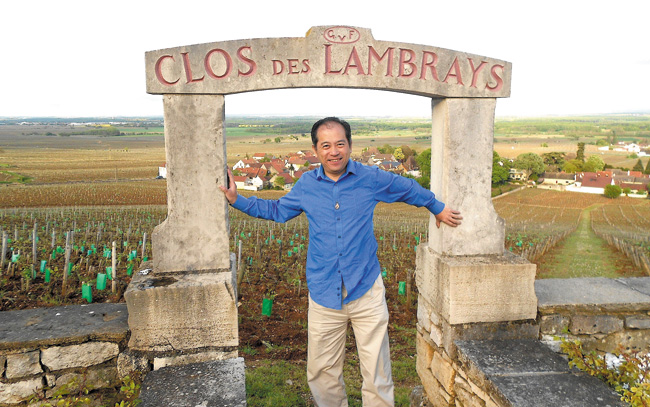 Nelson Chow au Clos des Lambrays
Nelson Chow au Clos des LambraysThe domain François Carillon was the first one to be visited. Present at Puligny-Montrachet, a municipality of the Côte de Beaune, it gradually gained its reputation. In Burgundy, the reference to history is omnipresent. The François Carillon domain indubitably consolidates this impression. No doubt, the family marked the Burgundian vine growing since numerous generations.
From the XVIth century, they appear at Puligny-Montrachet. From 1700, they introduce the vine growing on their plots of land and from then, gradually turn towards quality as technology evolves. From this perspective, François Carillon dedicated himself to vine growing from 1988. After having shared a domain with his father and brother, François Carillon concentrated his talent on the 6.5 hectares that are now his. These plots of land spreading out between the terroir of Puligny-Montrachet, Chassagne-Montrachet and Saint-Aubin produce peculiar wines.
These diverse appellations produce beautiful wines. François Carillon, striving to perfect his approach, manages to release elegant, sophisticated and pure lines and notes. Somehow the very essence of the wines. He especially stands out thanks to his exceptional chardonnays. This characteristic grape variety from Puligny-Montrachet and Chassagne face a real recognition in 1937 with the creation of two protected designations of origin. With four Premier Crus (Les Combettes, Les Perrières, Les Champs Grain, Les Folatières) and a Grand Cru (Chevalier-Montrachet), François Carillon has an interesting range of Puligny-Montrachets. There, through subtle choices during the elevage, he refines the scents of every wine. After manual harvests, he vinifies every cuvée in the same way. The alcoholic fermentation lasts between four and six weeks then comes the malolactic fermentation. Every wine evolves one year in a barrel then six months in a vat to perfect its elevage.
His cellar are at ground level and conceals some precious wines. Nelson Chow agrees on it, this mineral and pure style is characteristic of the great Puligny-Montrachets. Nine wines are presented for tasting. It is a horizontal tasting, the cuvées being almost all of 2014:
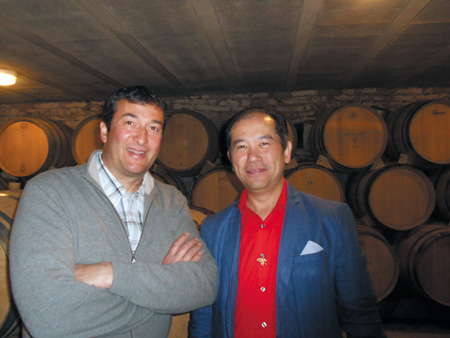
François Carillon and Nelson Chow.
Of all the domains visited during this 'enologico-touristic' road trip, Chanzy is the experimental one par excellence. At the edge of experience and avant-gardism, the domain introduces other possibilities and considers innovation. In this way, Chanzy embodies at the same time the Burgundy of another time and that of the future.
Anchored within the village of Bouzeron situated at the top of the Côte Chalonnaise, the domain was created in 1974 by the Chanzy family. The advertising group Sport SAS was the owner in 2008 for a few years. The company then fails and has to stop its activity.
In 2012, the investment group OLMA, specialized in luxury, acquires it. From that moment, the operating strategy changes and a vanguardist notion dominates. Under Philippe der Megreditchian's impetus, chairman of Chanzy since 2012, the team changes. The impact is radical. In 2013, Jean-Baptiste Jessiaume integrated the group, becoming the managing director. One year later, he becomes the manager of the company and the head of the operations. His creativity in wine-making, his efficiency makes of him the ideal candidate. In 2012, he received the Trophée des Jeunes Talents de la Côte de Beaune awarded every year by the Group of Young Professionals in Viticulture to the novice wine growers of excellence.
His innovative convictions amount to a regenerating breath for the domain. In agreement with the investors' consortium, he infused a radical questioning of the perception of the wine. The precious fluid literally metamorphoses. On his clay and limestone slightly marly soil he produces Chardonnay and Bourgogne Aligoté. In both cases, he refuses to consider the vines with a conventional point of view. Certainly, he has the nimbleness and the intelligence to use his knowledge of the wine, of the terroir but resolutely chose to do it differently. His work within the Jessiaume family company at Santenay undoubtedly gave him solid bases. His knowledge of the vine and the wine are magnified by a free interpretation, his.
Bouzeron Clos de la Fortune that Chanzy has the monopoly of is a perfect expression of it. Stemming from the Bourgogne Aligoté grape variety, it presents notes of lemon. This 2014 cuvée, still maturing at the moment, translates a beautiful minerality and an interesting acidity. Tension is perceptible. Fine lees are still present. The wine has been racked just one week ago. This wine already reveals an unusual potential. Jean-Baptiste Jessiaume explains the reasons. The vineyards from which it arises bloom on the Coteau de Bouzeron, parallel to the most famous ones of the Côte-d'Or. Certainly, this wine is not a Premier Cru nor a Grand Cru by its appellation but it has the material of it. The sunshine it benefits from provides it with elegant and sophisticated typicalities. It will be matured at 80% in stainless steel tanks and at 20% in barrel. It will preserve on the palate the freshness of the grape variety and a certain roundness, very delicate.
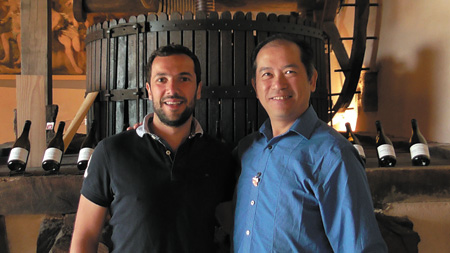
Jean-Baptiste Jessiaume and Nelson Chow.
In this early morning, Nelson Chow seems delighted to discover a very stylish Bourgogne Aligoté. The Bouzeron Village appellation, typical of this locality, finds a singular expression in it. The tasting continues with a Mercurey Les Caraby of the year. This Chardonnay is a surprise by its delicate notes of lime, almost honey. In view of its very young age, the wine should be exceptional. Aged 10 months in barrels, with 20% new wood, he pursues his refining in stainless steel tanks for 5 months.The Côte de Nuits shelters prestigious domains with a glorious past. The Clos des Lambrays at Morey-Saint-Denis does not escape the rule. Mentioned from 1365 in the inventory of the Abbey of Cîteaux under the name “Cloux de Lambrey”, it was divided into 74 owners during the French Revolution. From 1868, a reunification became possible. In a hundred-year time, the ownership changed several times, acquired by numerous families. Almost neglected under the management of Renée Cosson, at the point it was nicknamed "Sleeping Wine Beauty", it revived in 1979 under Roland de Chambure and the Saier brothers' impetus.
Enologist Thierry Brouin manages the technical part of the domain for them. While Clos des Lambrays was purchased by LVMH and Bernard Arnault in March, 2014, he stays. He perpetuates a certain look, a real qualitative perception. Arrived shortly before the classification of the Clos des Lambrays as Grand Cru on May 27th, 1981, he kind of embodies the memory of this domain and seems to guarantee it. 35 years of presence... Certainly, he admits he will leave in 2017. He will then leave the function of estate manager but will ensure the transition for two years by training his successor.
Whatever, when Thierry Brouin goes to the cellar, he almost transforms. This is what he prefers. You can see and feel it. Walking alongside the raws of barrels is like being initiated to other customs. The light that subtly penetrates contributes to the effect and intensifies the idea. Thanks to a delicate play of clair-obscur the barrels are highlighted, almost revealed to the visitor's eyes. The cellar disconcerts by its unusual side. The barrel bungs themselves are evidence of this by their shape and material.
The domain totals 8.6 hectares in production out of which 90% are classified Grand Cru. The Pinot Noir and Chardonnay varieties represent the basis of the production. In this early evening, four wines were tasted by Nelson Chow: Morey-Saint-Denis Village 2014, and several Clos des Lambrays (2014, 2013, 2012). The 2014 is a surprise by its freshness, its sharpness of tannins. Thierry Brouin explains the reason. Once the manual harvest is finished, the grapes are not destemmed. The juice is extracted in tanks with a pneumatic press in order not to develop to much the tannins.
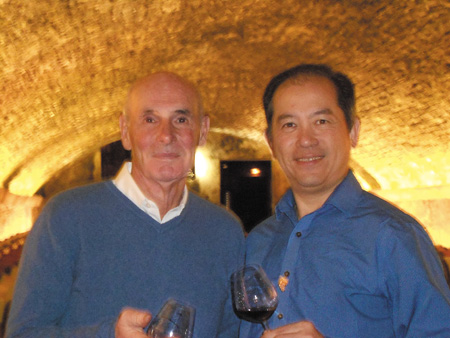
Thierry Brouin and Nelson Chow.
The 2013 is tense with notes of spices. The whole is elegant, subtle. Nelson Chow notices the work made by Thierry Brouin. He evokes the interest of his approach giving rise to high-end wines worth ageing but also enjoyable quite rapidly. In this way they perfectly match the expectations of both the Hong Kong and Chinese markets. Moreover, the domain is already represented in Hong-Kong by Altaya Wines Limited.
Elsewhere in Asia, their network consists of Wine Symphony Co in Taiwan, Enoteca and Vinorum Co in Japan, Best Cellar Co in Thailand. Clos des Lambrays asserts itself as a safe bet at export. This atypical enclave becomes a sought-after place as much as the wines.
The Ponsard-Chevalier domain blooms in the Côte de Beaune. On the outskirts of the village Santenay, the family company perfects its wines. Created in 1977, it was first Michel Ponsard and Danielle Chevalier's initiative. From the beginning, they opted for integrated farming and the protection of the environment. The 6.5 hectares vinified today produce mainly PinotNoir but also Chardonnay, Aligoté. The Pinot Noir expresses itself in a Bourgogne, a Santenay Charmes Dessus, a Santenay Premier Cru Beaurepaire and several Maranges. Four Premier Crus are to be remembered: Premier Cru Maranges 'Clos Roussot', Premier Cru Maranges 'Clos des Rois', Premier Cru Maranges 'La Fussière', Premier Cru Santenay 'Beaurepaire'. The Chardonnay reveals itself through the Bourgogne and the Santenay 'Les Daumelles'. The Aligoté is less present in the production.
An undeniable asset for this domain is the average age of the vineyards: 50 years for the red wines and 30 years for the white wines. Focusing on quality, the grape harvest is done by hand, the berries also sorted manually. The wine making continues with traditional foot treading for the red wines with vatting in stainless steel tanks for two to three weeks. Then comes the barreling in oak vats. The wine will perfect there from 12 to 15 months. Chardonnays will evolve smoothly with a progressive pressing. Fermentation is undertaken in barrels for 8 to 12 months.
In this late morning, Nelson Chow discovers Michel Ponsard's work. The latter perfectly masters his subject. He exudes the serenity of those who are sure of what they do. Wine growing is now an obvious thing for him, he knows the difficulties, he dominates the hazards. The visit of the cellar continues with his wife and his daughter, Coralie, committed in the future of the domain. The cuvées of the year, not bottled yet, are tested one by one. The delicacy of the Pinots Noirs can already be felt.
Things become clearer. The previous vintages are tasted in an appropriate space. There, the taste buds are ready for discovery. Santenay 'Les Daumelles' 2003 delights them undoubtedly. Its pale gold colour announces its subtle delicacy. In the nose, it exhales delicate aromas evoking the juniper berry and the citrus fruits. On the palate, the aromas become clearer. A beautiful acidity and some notes of white flowers can be noted. Supple tannins, a silky side and the length on the palate are undeniable qualities.
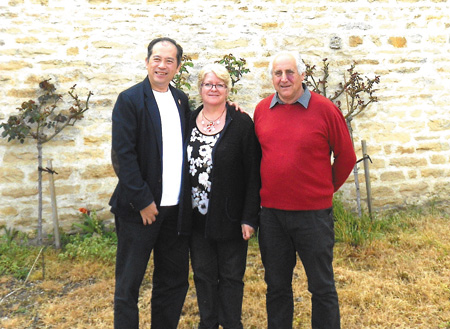
Nelson Chow, Danielle Chevalier et Michel Ponsard.
The Maranges 1er Cru ‘Clos des Rois’ 2009 reveals to be splendid. The vintage is a reference for the Côte de Beaune and Côte de Nuits. The visual aspect asserts itself in an intense ruby-red colour. The nose releases notes of red berries, spices. On the palate, it becomes evidence. The wine has an exceptional signature. No doubt, it could create real addictions. Delight for epicureans, it concentrates flavours of black cherry, spices. A light woodiness appears. The tannins are delicate and the length is interesting. To be noted, the soils of this plot of land partially consist of fossils. The shells of the latter are visible and add complexity. In this substratum of limestone and marls, the Pinot Noir retranscribes its magnificent complexity.
Discreet, attentive, Michel Ponsard is honest. He almost stays in the background, the accent being set on his production. Nevertheless, it has to be admitted, beyond the soils and the magnificent climats of Burgundy, the man's, the wine grower's knowledge and experience are inevitable. They give the wine its grandeur. A beautiful achievement!
— www.domaine-ponsard-chevalier.com —
Bernard Hudelot is a real character. After studying sciences, he made a radical turn and chose enology. He now teaches at the University of Burgundy. Wine grower since 50 years in Burgundy at Villars-les-Fontaines, he is in total symbiosis with the idea of viticulture. Since 1977, he inspires this 33-hectare domain with a real revival. Worthy spiritual descendant of the canons of Saint-Denis, the first who implemented wine growing there, and of the Dukes of Burgundy, he fiercely defends his territory. In the XIth century the religious community has created the vineyard then called ‘Villars-sous-Vergy’. The Dukes have been its owners from the XIIth century.
Located in the Hautes Côtes de Nuits, the place overhangs the plain of the Côtes de Nuits at an altitude of 400 meters. It is ideal for the growing of the Pinot Noir and is becoming perfect for the Gamay. The estate produce three types of wines: Bourgogne Aligoté, Bourgogne-Hautes-Côtes-de-Nuits in the three colours (white, rosé, red), the future Bourgogne Grand Ordinaire (Gamay). Bernard Hudelot carefully watches over his wines.
It all starts with the grapes. The vineyard is covered with grass, treatments are limited. The grapes are hand picked. A first sorting is done manually, a second one on a vibrating table. Then the bunches are destemmed and the grapes treaded. The 'Bernard Hudelot touch’ comes at that moment, for the vinification. The red wines are vinified for two to three weeks. It enables the tannins to develop in the best possible way. Fermentation on skins is operated at low temperature in open vats. The élevage process is unequalled. The trend in Burgundy now is to shorten the ageing time, access to consumption is made easier. Bernard Hudelot has chosen a radically opposite policy.
To him a very long élevage sustains the qualities of the wine, magnifies them. The white wines are left 18 to 24 months in the barrels, the red wines 30 to 48 months. After botlling the cuvées are kept for a very long time. Bernard Hudelot specifies he likes to perfect the wines for many years, sometimes 35 years, maybe more. He smiles, patience becomes an art. Nelson Chow listens, obviously seduced by such a conception. Diversity always reveals to be a richness.
The degustation starts. The Bourgogne-Hautes-Côte-de-Nuits Les Genevrières 1985 presents a grand finesse on the palate. Hints of humus are unveiled. The moment is precious. The Pinot Noir verges on excellence. Usually this terroir provides it with scents of humus, truffle, red fruits. The Bourgogne-Hautes-Côtes-de-Nuit Les Jiromées 1997 is to be enjoyed with relish. On the palate, it develops notes of fresh butter, salt, kumquat and candied citrus. The wines surprises, fascinates. The Chardonnay nearly becomes perfection.
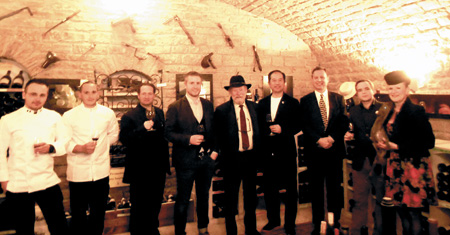
Au cencre, Bernard Hudelot et Nelson Chow.
Contrary to Philippe Le Hardi who prohibited the grape variety Gamay in 1395 in Burgundy, Bernard Hudelot wishes to give it a new place. To him the Gamay of the future can be a counter to global warming.
The wine grower does not stop with this. In order to resist to the banks' lack of entrepreneurial spirit, he created the concept of “Les Vignerons du Cœur”. 28 hectares of the domain have been grouped into a agricultural land grouping and sold to smallholders. The latter ensure a continued existence to the experience and make it viable. The domain thus becomes financially autonomous. Its legal and ownership structure make it the 'ideal estate', pure creation of a fruitful imagination. It seems inspired by the 18th-century humanist philosophers. The challenge is unique in Burgundy. Real self-sufficiency becomes the objective.
To be specified, Bernard Hudelot, a real character, is committed in other challenges. Among others, he practices as a consultant with “Vignerons de l’Impossible”. As such he advises Dominique Auroy for his estate in Tahiti.
Bernard Hudelot has made his choice, he refuses fashion things. Being hardy, he becomes vanguardist. Having a talk with him is an experience. He is able to transform the very moment; to consider the most extravagant projects and … carry them out successfully.
— www.chateaudevillarsfontaine.com —
The domain exists since the XIth century. From the end of the XIIth century until the French Revolution, it was indirectly linked with the politics and justice of the region as owner Pierre de Blancheton was a lawyer at the Parliament of Burgundy. In the XIXth century the Serre family really marked its future by working on the architecture of the building and increasing the surface area of the vineyard. Under Count de Moucheron's ownership, the domain was a quarter of the current surface area. In 1973, the founder of the Kritter group and the Patriarche House purchased this heritage. He undertook to restore the château. With this same objective of respect and enhancement of this heritage in mind, the Halley family bought it in 2012. The goal was clearly set: to develop wine growing with a high end target and enhance the image in France and abroad.
On 60 hectares, the Pinot Noir, Chardonnay, Bourgogne Aligoté grow to give their best. After hand picking, the berries are delicately sorted out on a table enabling to remove the damaged grapes. Nelson Chow appreciates the tasting organized with Olivier Halley. Thirteen white wines, mainly Meursault, reflect the history and typicality of the domain.
Château de Meursault, Meursault-Charmes 2012 stems from a plot of land, Les Charmes, located in the southwest of Meursault. After the harvest the destemmed grapes are gently pressed with a pneumatic press. Undoubtedly this results in delicate tannins and preserves the subtle aromas. The static clarification clears the musts. The wines are then placed in oak barrels for alcoholic fermentation. They will age in 35% new barrels or in once- or twice-used barrels. Blending is done just before bottling after a 15- to 18-month élevage. The colour is of delicate gold. In the nose, notes of yellow-fleshed fruits appear. On the palate, the freshness marries with minerality, the soils being calcareous. A hint of fatness can be felt, in direct link with the marley limestone of the substratum.
Thirteen red wines among which a Grand Cru (Corton) and six Premiers Crus give an interesting overview of the subtleties of the soils. Aloxe Corton, Savigny, Beaune 1er Cru, Pommard 1er Cru, Vougeot 1er Cru et Corton Grand Cru open a wide range of possibilities. Château de Meursault Pommard 1er Cru Clos des Epenots 2009 attracts. After the harvest the destemmed grapes are vatted for 15 to 18 days.
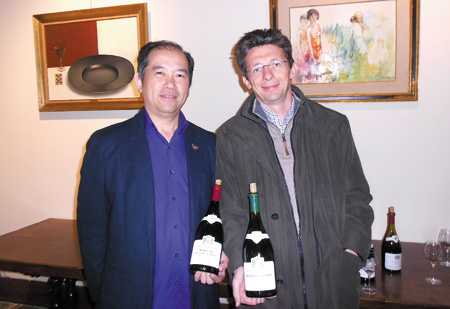
Nelson Chow et Stéphane Follin-Arbelet.
The maceration gives the juice its colour and aromas. To enhance it, the cap is punched and pumped over. The wine has been aged 15 months in 30% new barrels and 70% once or twice-used barrels. The colour is intense red. In the nose, the scents of black fruits and spices dominate. On the palate, the fruits are confirmed and a beautiful balance can be felt. The soil of this plot between Beaune and Pommard is calcareous with a lot of alluvia. That is where the balance comes from. The moment is precious, here in this château at the heart of Meursault, surrounded with a collection of pieces of art. The creativity linked with the wine growing field, or purely artistic, can equally produce small wonders.
For one day, president of the sommeliers of Burgundy Michel Smolarek decided to take part in the trip through the vineyards. Just one day, with the visit of two domains: Jean-Marc Boillot and Philippe Leclerc. By his knowledge of the terroir and wines of Burgundy, he shed a special light on the tastings.
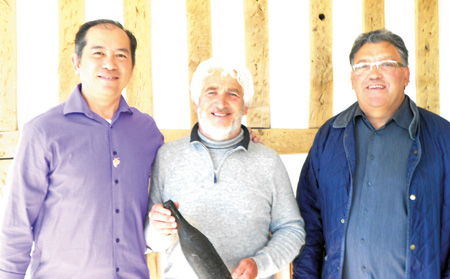
Nelson Chow, Jean-Marc Boillot and Michel Smolarek.
Enjoyment of the moment, silent smiles of implicit agreement, discovering the white wines, appreciating each second is a relish. A Meursault 2013, a Puligny-Montrachet 2013 have been a beautiful starter. Then the Puligny-Montrachet Champ Canet and Les Combettes 2013 have been appreciated. Both cuvées stem from old vines planted by Etienne Sauzet, one of Jean-Marc Boillot's grandfathers. They deserve a special attention for their beautiful style. The Puligny Champ Canet 2013 presents heady notes of lime at first taste, and the an interesting roundness and delicacy. The Puligny-Montrachet Combettes develops some kind of roundness at first taste then a bit of fatness with a lovely acidity provided by some notes of lime. A last wine was appreciated, even more peculiar, a Puligny-Montrachet Les Combettes 1994. There, delectable notes of almond, kumquat, brioche coat the palate. The whole surprises with an enjoyable refreshing side.Philippe Leclerc is an unusual personnality. Introduced by his father to wine growing, he has somehow grown up naturally integrating the notion. He works intuitively, improving his approach in a empirical and efficient way. His forty years of experience in the field enable him to step back in front of fake experimentations and fashion things. There, in his cellars in the centre of the village of Gevrey-Chambertin in the Côte de Nuits area, he crafts wines that are representative of the appellation. Full-bodied, with marked tannins, he favours the expression of the Pinot Noir and this specific terroir. Powerful, long-lasting on the palate, his wines assert their identity. With several plots of land, he highlights the different terroirs by crafting a range of Gevrey-Chambertins with distinctive flavours. A kind of collection...
Philippe Leclerc is attached to his vineyard, it is a part of him. To preserve it, he resolutely chose integrated farming including organic fertilizers and a limited amount of treatments. The Pinot Noir gets special attention. As a wine grower, he wants to control the various stages of the production and marketing of his wine. About marketing, he sales the major part of his production in France and 1/3 at export. He currently has no special contact in Hong Kong or China. Export to these countries are occasional.
The tasting takes place in his shop with an unusual décor. Ten wines are presented. The first one is Chambolle-Musigny Les Babilles 2011. For this cuvée, the new barrels represent 50%. To reduce the influence of the wood, Philippe Leclerc leaves his barrels open to the air to limit the impact of the sap in the wood. The notes of black fruits are present, the structure is asserted, the tannins quite supple. Philippe Leclerc specifies the grapes are not destemmed before vinification. But with less punching of the cap and more pumping-over, no bitterness appears and the tannins are preserved. This wine, nearly light compared to other appellations of the Côte de Nuits area, stands out by its fruity notes and its delicacy.
Several Gevrey-Chambertins (2012, 2011, 2010) like Gevrey Chambertin 1er Cru Les Champeaux 2012, Gevrey Chambertin 1er Cru Les Champonnets 2012 are different. More or less tannins, more or less full-bodied structures define them until the Gevrey Chambertin 1er Cru Les Cazetiers 2010. The latter offers on the palate notes of black fruits and reveals suppler tannins. Very well- made, it is elegant and rare.
Nelson Chow considers these wines are young in view of their potential. The perfect refining of their tannins should take some more years. He recognizes their typicality and specificity. Michel Smolarek, president of the association of sommeliers of Burgundy, knows Philippe Leclerc and his wines. He appreciates the quest for perfection and self-questioning of the wine grower for each cuvée.

Philippe Leclerc devant le musée de la vigne.
Since 1926, the Louis Picamelot Estate crafts Crémants. Founder Louis Picamelot has soon been introduced to the Crémants and traditional method. From 1822, the Champagne wine growers came to Burgundy to teach their fermentation method. Louis Picamelot heard of it. The challenge it was to make a sparkling wine based on double fermentation attracted him. From 1926, he created the company and started producing less than 4,000 a year. First he vinifies for others, some fifty wine growers. In the early 2000s his grandson Philippe Chautard takes over the management of the estate. He refocused his activities, buys vineyards and vinifies his own wines.
Now he perfects his production and promotes it in France and abroad. President of the Cremants of Burgundy Federation, he defends a quality product that has real legitimacy. He understands the stakes of Asia and especially Hong Kong and China. For the moement, he does not export there. He plans to do it by educating this potential clientele to the art of Crémant making in its best expression.
Nelson Chow's presence enables to evoke the trade. In Rully, Philippe Chautard specifies the different terroirs of the domain: Hameau de Gamay, Puligny-Montrachet, Saint-Aubin 1er Cru Les Murgers des Dents de Chien, Saint-Aubin 1er Cru en Remilly. He mentions the grape varieties he uses Pinot Noir, Chardonnay, Aligoté. A few moments later he explains the different stages of the sparkling wine making, showing the related technology. Vatting starts with delicate pressing with pneumatic presses. The scents express, the tannins remain fine and elegant. The first fermentation is operated in tanks or barrels. In this case he precises he does not want to make the wine too woody but only to refine the tannins. The second fermentation is undertaken in the bottles. On the lees, in the cellars at a temperature of 12°C, the process can be carried out quietly. The Crémants remain there 12 to 48 months (48 for the Cuvée Jean Baptiste Chautard). The House decided to stand out by a long ageing time that guarantees the quality of the Crémants and the finesse of the aromas/ The bottles are regularly riddled in order to make the removal of the lees easier afterwards.
A walk through the vineyard of Saint-Aubin 1er Cru en Remilly enabled Nelson Chow to better comprehend the care given to the vine. During a dinner at the Restaurant l’Amaryllis in Saint-Rémi, he tasted different cuvées of the range. Chef Rémi Burtin concocted a made-to-measure menu to highlight the subtleties of each Crémant. They are seven. Each of them express a terroir, a history.
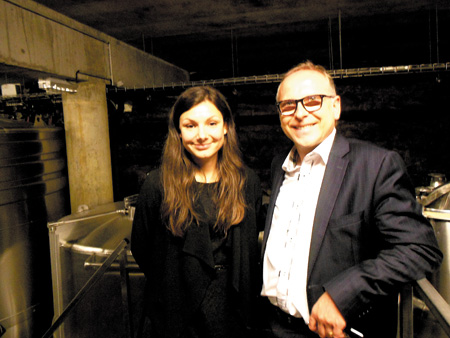
Chloé Friedmann and Philippe Chautard.
The Cuvée Jean Baptiste Chautard deserves a particuliar attention. Dedicated to one of the members of the family, it reveals a subtle delicacy. The colour is a refined golden colour. On the palate it develops beautiful notes of fruits, citrus, delicate bitter almonds, white blossom and an interesting pure line. This Blanc de Blancs Brut meets the requirement of the cellar master. The bubbles are fine on the surface. They pleasantly tickle the palate. It shows a certain tension. This alliance of (68%) and Aligoté (32%) pleases.
Terroir de Chazot, Crémant de Bourgogne Blanc de Noirs Brut, stands out by its scents and pure style. This 100% Pinot Noir translates the subtleties of the terroir of Chazot, on the hills above Saint-Aubin.
To taste, for the pleasure of the senses and understand the Burgundy terroirs.
The domain Moissenet Bonnard located at the heart of Pommard has known eight generations of wine growers. Since 1987, Jean-Louis Moissenet-Bonnard watches over the developement of the family domain. First he produced grapes he sold to another house. In 1995, he changed the policy and decided to vinify himself. From then his perception changes. Since a few years he is supported by his oldest daughter Emmanuelle-Sophie.
Together in the family house in the middle of Pommard, they defend faultless and vanguardist ethics. Special care is given to the ploughed grounds and integrated farming. Emmanuelle-Sophie specifies, the organic certification is not a temptation. She wants to respect the soils, use natural products but she does not want to be submitted to the strict requirements of the certification. Her fight lays in something else. More innovative, she got the certification High Environmental Quality in 2014. It requires to preserve the walls on the plots of lands, the trees, the insects that are not harmful for the vines, let the grass grow in the vineyard… Now that the cliamts have been listed by the UNESCO, the stakes are quite significant.
The 6-hectare domain has Chardonnay (30%) and Pinot Noir (70%). With the later they started to produce Crémants. Some 25,000 bottles stem from one only plot of land. On the palte it develops a beautiful acidity. During the tasting in the beautiful cellar, its freshness and density of the bubbles pleasantly surprise. The morning started well. In this perfectly organized cellar Nelson Chow can concentrate on the viticultural production. He is presented fourteen wines are presented.
The tasting starts with the white wines. The Beaune 1er Cru Montée Rouge 2013 is the first vintage of this appellation produced by the estate. The hue is tinted with gold and delicat green. On the palate flavours of almonds, fer and white blossom appear. The Auxey-Duresses Les Fosses 2013 with its clear gold colour unveils notes of almonds, apple. A Meursault Les Vireuils 2013 with its green gold hue, scents of citrus are evidence of a beautiful developement. These three wines are elegant and already present a beautiful acidity. To be noted, the Meursault is a bit fatter.
The red wines are good surprises. Nelson Chow is interested in the Beaune Village Montée Rouge 2012. He asks for the price and agrees it matches the trends on the Chinese market. Medium range wines that can develop good opportunities and whose prices are not oversized are sought-after.
The Auxey-Duresses 2012 reveals to be interesting with powerful notes of black fruits. Emmanuelle-Sophie confirms she continuously seeks the expression of the fruit, the freshness. Therefore she ages all the wines 12 months in barrels. She does not wnat to stress on the woody notes. For the same reason she only uses 30% new oak to facilitate the oxydoreduction and the developement of fine and elegant aromas. In this respect she perfectly corresponds to the new trend in Burgundy that refuses excessive woodiness and omnipresent tannins. The elegance, suppleness of the latter are the rule. Nelson Chow recommends 4 to 6 years ageig to enable the best expressiono of the aromas.
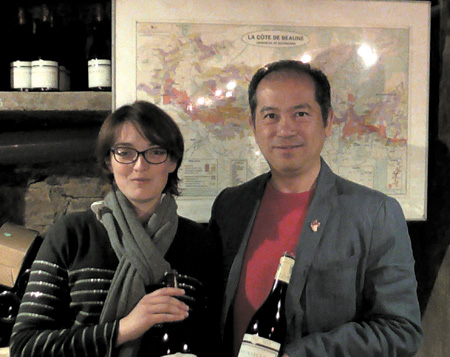
Emmanuelle-Sophie Moissenet-Bonnard and Nelson Chow.
Later several Pommards are tested: Pommard 1er Les Charmots 2011, Pommard 1er Cru Les Peyzerolles 2012, and the beautiful Pommard Les Epenots 2013. The latter stems from old 90-year-old vines and offer a magnificent interpretation of the appellation. The cuvée 2012 is a bit special. The structure is present, with subtlety. The tannins are supple. Notes of black fruits are revealed on the palate. A delicate freshness exude from the wine.
Now demonstrated, Burgundy is a scene of expression for talented wine growers. The Moissenet Bonnard family undoubtedly knows how to stand out by their approach. Their talent is recognized in France but also abroad with the export of 66% of the production, mainyl to USA and Japan. China is still a market to conquer for them.
Château de Pommard is one the oldest domains of the eponymous city in the Côte de Nuits area. Created in 1726 by Vivant Micault, it had to be like a jewel box for the produced wines. The secretary of Louis XV considers these vineyard has a powerful potential. En 1763, Claude Marey, at the head of the domain, travels through Europe and takes the opportunity to promote his wines with his prestigous hosts. A real craze arised for the wines from Pommard in Germany, Flanders, Italy, countries in the North. The orders follow each other. Château de Pommard becomes an inevitable stopover for the upper class, even for the Queen of Sardinia.
From 1939 to 2003, the Laplanche family, native from Nuits-Saint-Georges, historically wine growerss and merchants, invest in the place. In 2003 and until 2014, the Giraud family watch over the destiny of the estate. Maurice Giraud decides to become a reference in France and Abroad. He invests in a collection of contempary art pieces. From 2009 he organizes exhibitions (Dali, Keith Harng, etc..).
About viticulture, he has to take control on the vines. Therefore he changes the team, considers other methods for the viticulture and the vinification. He wishes to make inevitable wines, referenced among Burgundy's fine wines. From now on the estate is among the necessary stopovers for tourism and wine tourism in Burgundy. He then welcomes 35,000 visitors a year. In 2014, Michael Baum, entrepreneur in the Silicon Valley, invests in this jewel of 20 hectares. Aware of the potential, he decides different projects related to viticulture. A new vathouse, a restaurant with a view over the vineyard are in planed.
In this late morning, Nelson Chow notes the different aspects of the domain. Together with the cellar master Emmanuel Sala, he visits the cellar. There the different wines used for Château de Pommard are perfecting. Five different terroirs compose it. Grand Champ provides the structure to the wine. Veru calcareous, the soil gives a powerful wine. Les Paules give the flesh. The terroir, rich in clay, produces supple, silky tannins with a noce breadth. Nadine has the same function. Stemming from a samely rich clayey soil, its inwe gives the finesse and elegance. On the palate, notes of forest fruits, roundness appear. Simone has the most complex terroir. It magnifies the cuvée and leads it to excellence. Chantreriehas the same influence. The vinification is longer for the old vines. The oldest one, at Chantrerie, is 100 years old, Grand Champ 75 years, Nadine date back the 50s.
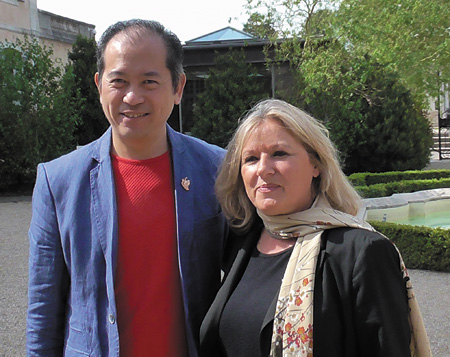
Nelson Chow et Anne Bavard-Brooks, conseillère en vin.
Later during the visit, Emmanuel Sala explains his approach. He carefully watches over the blending in order to respect the expression each wine. He has an exceptional touch. In the tasting room, he organized a vertical tasting. Château Pommard 2008 is wonderful. Notes of roses, white blossom, undergrowth mingle to give their best. A powdery side appears. The 2009 confirms the perceptions. Splendid! The scents of undergrowth are less present. The 2010 vintage develops quite the same accents, the powdery side being less powerful. The 2011 vintage surprises by its spicy notes. Beautiful vintages!
Each owner wished to improve the domain and its wines, help it to get a splendid reputation. The result is conclusive, Château de Pommard undeniably deserves its place among the fine Burgundy wines. Emmanuel Sala's undoubtedly helps it.
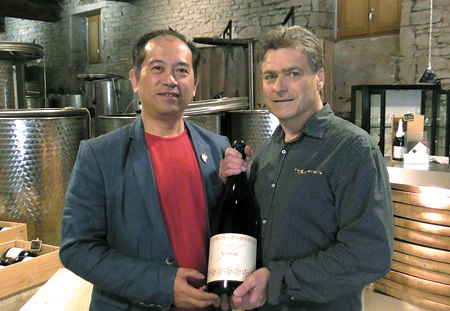
Nelson Chow et Pascal Marchand
A vertical tasting of Chassagne-Montrachet 1er Cru Abbaye de Morgeot shows the subtlety of the terroir. The cuvée 2013 already presents notes of milky oysters and lemon whose fragrances will probably develop. The freshness in the mouth offers pleasant sensations. The 2012 is very open. The notes of milky oysters, the beautiful acidity are there again. The 2011 is splendid. For Nelson Chow, the minerality is obvious, close to the Pulignys'. It is some drier but less long-lasting on the palate. The 2010 is different. The harvest has been carried out later. It is the first cuvée crafted here. The wine is less elegant, like a prototype that has to be 'adjusted'.Created in 1999 the La Vougeraie domain reflects the commtiment of a family over three generations to start with Louis Boisset, the grandfather until his grandchildren Nathalie
and Jean-Charles.
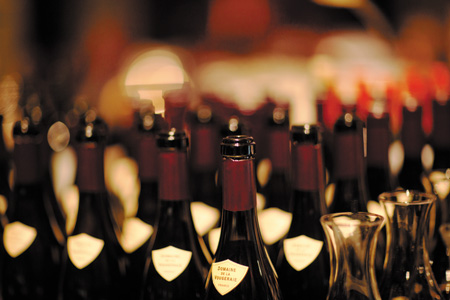
— www.domainedelavougeraie.com —
The Louis Latour house is inevitable in Burgundy. Settled at the heart of Beaune, it is reminiscent in France and abroad of a name inseparable of the Grands and 1st Crus. The house, with a direct link in History, has a wealth of two centuries of existence.
Founded in 1797, it managed to evolve through time and resist to politic and weather hazards. Undoubtedly since 1997 and its entering the Hénokiens Club (gathers the leading companies of the industry that managed to remain within the founding family for at least 200 years and that have kept the name of the founder), the entreneurial path has been even more valued.
The initial property, created in 1731 by Denis Latour, is born in the Côtes de Beaune area and Aloxe Corton. Progressively it developed to reach currently 48 hectares. Among them 27 hectares produce Grands Crus.
In this morning Nelson Chow has an interview with Marc Allen, export manager, about the specificity of the Hong Kong and Chinese markets. Undoubtedly the second one is more difficult to predict. Obviously, besides the recognized and efficient importers, one has to act skilfully and carefully. Indeed the wines have to be respected, kept onsite in perfect conditions and sold at a minimum price. Remain vigilant before and after is an absolute necessity.
Nelson Chow evokes the new laws wished by the Chinese government. They will concern China and, for some specific points, Hong Kong. Several commercial privileges might be suspended.Meanwhile many importers from Hong Kong sell foreign wines and spirits in China. The house Latour is vigilant. It has a real experience as it has soon noticed the necessity to promote their wines abroad. From 1815 registers evoke a first transaction with Great Britain. The official importer is Links Concept in Hong Kong. In China, the house is positioned in Shanghai with Pernod Ricard.
The tasting took place outside Beaune, in the cellar where vatting is carried out. It presented four